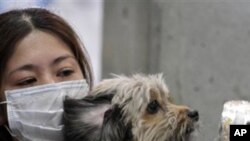The number of missing and dead from Japan's massive earthquake and resulting tsunami passed 21,000 on Sunday. Radiation exposure now is adding another threat to the population. The multiple disasters not only inflicted very heavy damage and casualties for people, they also had a devastating effect on animals.
Last week, a video posted on the internet from live Japanese television showed an abandoned and shivering dog, hair matted and dirty, skirting about wreckage in Sendai. The pet carefully guarded another dog which had been seriously injured and was lying on its side. The heart wrenching video has drawn more than eight-million viewers and exposes the plight that has befallen many animals in Japan.
Dr. Bernard Unti is a Senior Policy Adviser with the Humane Society of the United States and Humane Society International. As in most other large natural disasters, he says the situation in Japan shows the acute need for animal rescue and care.
"Even in the midst of this calamitous triple disaster, we have seen videos and footage of Japanese citizens trying to rescue their pets when they have very little left of their homes and their lives. It is a real testament to the human animal bond. And in that sense it really underscores what the humane movement is really all about," he said.
Unti says this disaster has a unique twist that rescue works had not previously encountered. "We do not have responders on the ground at the moment. We have a team stationed in the Philippines waiting to go in. But we have committed to fund local organizations that are working there. The main consideration preventing teams from going in at the moment is the certain risks of exposure to radiation in light of the damaged nuclear reactors. That is something we have not had to face in animal related response previously," he said.
He said animal needs are usually a secondary priority in large scale disasters. "As a practical matter, the emphasis in the early going is almost always on human needs and the human dimension of the catastrophe and the timing is such that the animal related impact and the focus on animals becomes a broader topic of concern a few days or even a week or two into the crisis," he said.
A huge animal response was mobilized six years ago along the U.S. gulf coast in the wake of Hurricane Katrina. Alex Chernavsky from Rochester, New York was among thousands of people who went to the New Orleans area. He says time was critical in the rescue effort. "There were a fairly large number of animals rescued at the beginning. But then the longer you went, the harder it was to get the remaining ones," he said.
Chernavsky says he was involved in some of the more difficult rescues. "What we were doing was getting the animals that were tough to get, which means if they were running loose outside they might be hard to catch or they were still trapped inside houses," he said.
Pet owners who were rescued themselves were not allowed by authorities to take their animals with them. That policy has changed after Hurricane Katrina. Bernard Unti of the Humane Society says another lesson learned is how well some animals can survive under extreme conditions.
"From Katrina we learned new facts about the capacity of certain animal species and certain individual animals to survive without food and relatively limited water for weeks and weeks. In a sense, we had to rewrite the animal physiology textbooks after Katrina. And then we saw not just the physical survival but obviously the will to survive that is so strong in all creatures," he said.
Strong survival instincts help animals live through disasters and give responders more time to find them. But Alex Chernavsky says being prepared ahead of time helps pets the most.
"Pet owners should have carriers ready to go for any cats they have. If dogs are small enough to fit in a carrier, then they should have those prepared so that they can evacuate on short notice. If they think they might get holed up in their house, they should have a stockpile of enough food and water to last at least a week or two. Most people do not do that," he said.
Microchip identification technology was not in widespread use at the time of Hurricane Katrina, and most animals rescued were never reunited with their owners. Microchips can now help the process, and Unti says that couples well with practical measures in emergency preparedness.
"You should have your animal properly [identified] if not micro-chipped and properly collared and tagged. You should always have a ready-to-go kit with emergency supplies and veterinary history and veterinary care information, basic medication. Learn the tricks of the trade for animals in the event that you are forced by whatever circumstance to leave [them] behind, leave water running, leave lots of food in the bathtub," he said.
He adds that animal rescue efforts Japan will need worldwide help from donations. "The long-term needs for recovery of animal care infrastructure in Japan are going to be very great. We really want to encourage people to invest their dollars in organizations with a good track record in international disaster response," he said.
Complicating efforts in Japan is the nuclear radiation threat caused by damage to nuclear power plants. The immediate and long-term consequences are forcing animal rescue organizations to adapt to the crisis and adjust response measures.
Japanese Disasters Also Leaving Animals in Peril











